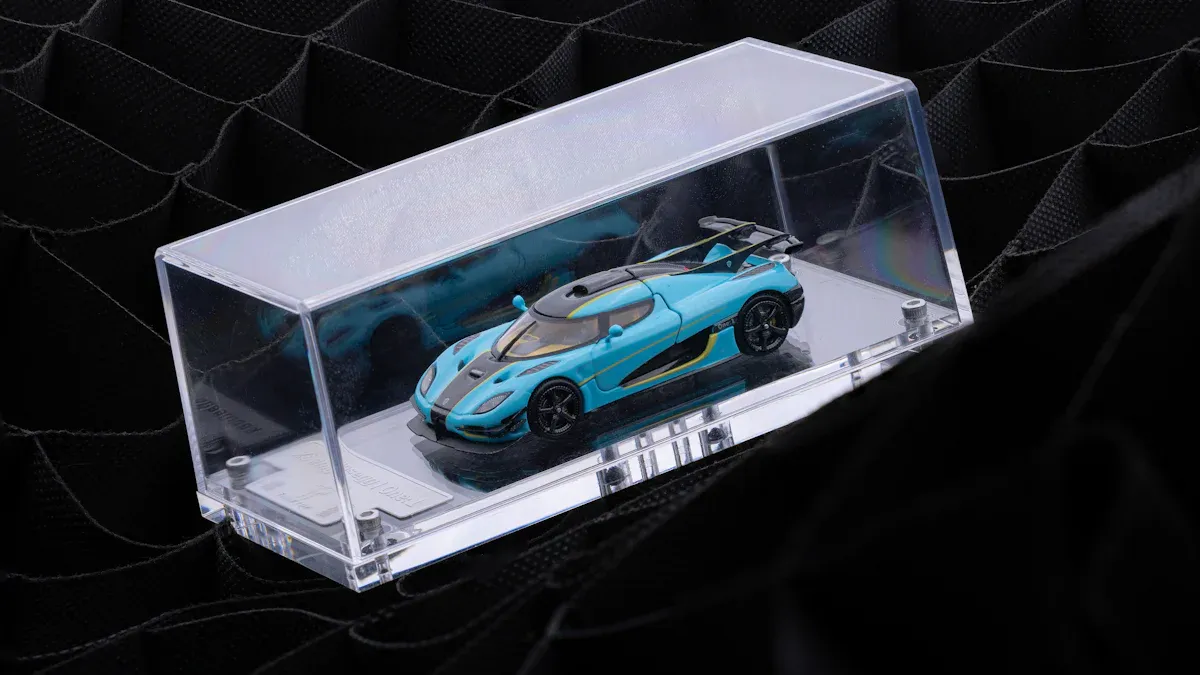For most collectors, acrylic is the best choice for display cases in 2025. The home display case market is growing, indicating more people are seeking superior protection for their items. Your decision between acrylic vs. glass hinges on a few key factors. You need to balance clarity, safety, and the overall aesthetic of your display. This guide helps you choose the right material for your valuable collectibles. We will directly compare acrylic and glass, and also examine materials like PETG to provide a comprehensive overview. Our aim is to help you achieve the perfect display, especially when considering what's best for collectibles.
Acrylic vs Glass: The Core Comparison

This is the central showdown in the acrylic vs glass debate. You need to know the key differences between acrylic and glass to make the right choice for your collection. We will compare them directly on the factors that matter most: how they look, how they protect, how they handle, and what they cost.
Clarity and Color Accuracy
You might think glass offers the best clarity, but that is not always true. The visual clarity of your display depends on how much light passes through the material and how much it bends that light.
Standard acrylic is naturally more transparent than standard glass.
Standard acrylic can transmit up to 92% of visible light.
Standard glass typically transmits between 80% and 90% of light.
This difference happens because most standard glass contains iron, which gives it a slight green tint. You can see this tint when you look at the edge of a thick glass pane. This can subtly alter the true colors of your collectibles. Acrylic displays, on the other hand, are inherently colorless, providing a truer color presentation.
Of course, you can buy premium low-iron glass (often sold under brand names like Starphire) that is exceptionally clear. However, acrylic still has an edge due to its lower refractive index.
Material | Refractive Index |
|---|---|
Acrylic | 1.490–1.492 |
Starphire Glass | 1.5183 |
A lower refractive index means less light distortion and glare. This gives acrylic displays superior display quality without needing expensive anti-reflective coatings. For pure, unaltered visual clarity, acrylic is often the winner.
UV Protection Levels
Sunlight and even indoor lighting can damage your items over time. Harmful ultraviolet (UV) rays cause colors to fade and materials to become brittle. This is where UV protection becomes critical.
In the acrylic vs glass comparison, standard acrylic offers better baseline protection. A standard sheet of acrylic inherently blocks over 80% of UV radiation, while untreated glass blocks very little. For any serious collector, this built-in feature of acrylic is a major advantage.
For ultimate protection, you can upgrade to specialized museum-grade materials.
Pro Tip: Both acrylic and glass can be treated to block up to 99% of UV rays. These "museum-grade" options are the gold standard for preservation. An acrylic display case with this feature offers the best of both worlds: safety and preservation.
This chart compares common glazing options. You can see how Optium Museum Acrylic provides the same top-tier UV protection and anti-reflection as Museum Glass but with less weight and more safety.
While a premium glass display case can offer excellent UV protection, acrylic provides good protection right out of the box and can be easily upgraded for maximum defense. This is one of the key benefits of acrylic over glass.
Weight and Handling
The weight of your display is a practical concern you should not overlook. Here, the acrylic vs glass choice is simple: acrylic is about half the weight of glass.
This significant weight difference has several benefits for you:
Easier Installation: You can move and set up acrylic display cases by yourself. A large glass display case often requires two or more people to handle safely.
More Placement Options: You can place lighter acrylic displays on shelves or furniture that might not support the heavy load of a glass display.
Lower Shipping Costs: If you order your display online, the lighter weight of acrylic will result in cheaper shipping fees.
For large displays or for collectors who may move their display in the future, the lightweight nature of acrylic makes it a much more convenient and versatile option.
Overall Cost and Value
When comparing the cost of acrylic vs glass, you need to look at the total value, not just the initial price tag. Standard, untreated glass is sometimes cheaper than standard acrylic. However, once you start comparing materials with similar features, the picture changes.
Tempered glass, which is a safer option than standard glass, costs on average between $18 and $38 per square foot. The price depends on thickness and features like low-iron clarity.
In many cases, standard acrylic is less expensive than tempered glass. When you factor in its built-in UV protection and lighter weight (which saves on shipping), acrylic often emerges as the more cost-effective choice.
The true value comes from balancing cost with features. An acrylic display offers excellent clarity, good UV protection, and superior safety at a competitive price point. A cheap glass display case might save you money upfront but offers poor protection. For collectors, investing in the right display means protecting your items for years to come. Therefore, acrylic display cases often provide the best long-term value. While we focus on acrylic and glass here, materials like PETG also offer unique cost-benefit profiles we will explore later. Remember that PETG is a strong contender. PETG is known for its durability. PETG is also very flexible. We will see how PETG compares. PETG is a great material. PETG is often used in food displays. PETG is a good choice for specific needs.
Durability and Safety
When you invest in a display, you want to protect both your collectibles and your home. The durability and safety of your chosen material are critical factors, especially in a home with kids, pets, or high-traffic areas.
Impact and Shatter Resistance
When it comes to durability, acrylic has a clear advantage over glass. Acrylic is significantly more impact-resistant. In fact, it can be up to 10 times stronger than glass of the same thickness. This means it can withstand bumps and impacts that would easily shatter a glass panel. The durability of PETG is also notable.
Material | Impact Resistance (J/m) |
|---|---|
6mm Annealed Glass | 1.2 |
6mm Acrylic | 15 |
The real difference appears during a breakage. If a heavy object hits your glass display, it can shatter into dangerous, sharp shards. In contrast, shatter-resistant acrylic is much harder to break. If it does fail under extreme force, it typically cracks into a few large, dull-edged pieces, making it a much safer option. The safety of PETG is a key feature.
Scratch Resistance
You should know that glass is naturally more scratch-resistant than standard acrylic. This is due to its surface hardness.
Tempered Glass: Has a Mohs hardness rating of about 6.
Acrylic: Has a Mohs hardness rating of about 3.
This means an unprotected acrylic surface can be more susceptible to fine scratches from cleaning or abrasion. However, you can easily overcome this issue. Many modern acrylic displays come with advanced anti-scratch coatings.
These coatings form a hard protective layer that maintains optical clarity and keeps your acrylic displays looking new for years. For durability, PETG is excellent.
Safety Concerns for Homes 🏡
Your home's safety is a top priority. With over 2.5 million home injuries related to broken glass furniture each year, the risk is real. Choosing acrylic display cases significantly reduces the danger of accidental breakage. The lightweight nature of acrylic also adds to its safety, as it is less likely to cause damage or injury if it falls. For ultimate protection and peace of mind, acrylic is the superior choice for a busy home environment. PETG is a safe material for homes. The flexibility of PETG is an advantage. Remember that PETG is a strong choice. PETG offers great impact resistance. PETG is a worthy consideration.
When to Choose Glass Display Cases

Acrylic may be the top choice for most, but glass display cases still hold a special place. You should choose glass when its unique qualities align perfectly with your display goals. Let's explore the specific situations where a glass display case is the superior option.
For a Premium, Elegant Look
You cannot deny the timeless, high-end feel of glass. It has a heft and crystal-clear brilliance that communicates luxury and permanence. Museums and luxury brands often use glass for this very reason.
For example, the Morse Museum uses glass to display prized works, including delicate glass art from Louis Comfort Tiffany. This choice enhances the perceived value and historical significance of the items on display. If you want your display to have a commanding, museum-quality presence, a glass display case delivers an unmatched premium aesthetic.
In Low-Risk, Permanent Setups
The weight and fragility of glass make it best for permanent installations. You should use glass display cases in areas with low foot traffic where they will not be bumped or moved. For maximum safety in a permanent display, you can take several steps.
Secure the Display: You should anchor heavy glass cases directly to a wall to prevent tipping.
Choose Safer Glass: Laminated glass is an excellent option. It holds together when broken, offering better security than tempered glass.
Reinforce the Structure: For valuable collectibles, consider a display with reinforced doors and pry-resistant locks. These measures make glass cases a secure fortress for your items in a stable environment.
When Scratching is the Main Concern
Glass is naturally harder and more scratch-resistant than standard acrylic. If your display is in a location where it might be subject to frequent cleaning or minor abrasions, glass will maintain its pristine surface better over time. Glass is also chemically inert and rigid. This makes it the ideal choice for creating a long-term, sealed display for sensitive items. Unlike acrylic, glass does not warp over time and provides a superior barrier against humidity, making it perfect for preserving delicate materials.
Exploring Other Material Options
While acrylic and glass are the main contenders, you have other material choices for your display cases. Understanding these alternatives helps you find the perfect fit for your specific needs and budget. Let's look at PETG, polycarbonate, and styrene.
PETG: The Flexible Alternative
You might consider PETG for its unique blend of strength and flexibility. In the glass vs petg debate, PETG offers superior impact resistance. It is a great middle-ground material. The glass vs petg comparison often highlights PETG's toughness. Many industries use PETG for its durability. You can find it in:
Food and Beverage Containers: PETG is food-safe and strong enough for transport.
Retail Displays: Its impact resistance makes it ideal for busy store environments.
Machine Guards: PETG protects equipment and personnel in industrial settings.
When comparing glass vs petg, PETG is significantly stronger. The glass vs petg choice becomes clear when impact is a concern. This makes PETG a very safe option. The glass vs petg discussion shows PETG is more forgiving than glass.
Material | Impact Strength Izod (ft-lb/in of notch) |
|---|---|
Acrylic | 0.4 |
PETG | 1.2 |
The glass vs petg comparison reveals PETG is a robust material. For collectors needing a tough and flexible display, PETG is an excellent choice. The glass vs petg matchup favors PETG for safety.
Polycarbonate: For Maximum Durability
When you need the ultimate level of protection, you should look at polycarbonate. This material is virtually unbreakable, making it a specialty choice for extremely valuable or irreplaceable items. Its strength is far superior to other options.
Material | Impact Resistance (compared to glass) |
|---|---|
Acrylic | 10-17 times greater |
Polycarbonate | 250 times greater |
Note: This incredible strength comes at a price. Polycarbonate is more expensive than acrylic and has slightly lower light transmission (around 88%). It can also yellow over time from UV exposure unless it has a protective coating. You should choose polycarbonate when security is your absolute top priority.
Styrene: A Budget-Friendly Option
If you need a very low-cost, temporary display solution, you might encounter styrene. It is lightweight and inexpensive, making it accessible for simple projects or poster frames. However, you must be aware of its significant drawbacks.
Styrene has very poor resistance to UV light. Exposure to sunlight or even indoor lighting will cause it to quickly turn yellow and become brittle. This yellowing happens because the plastic degrades, which alters its appearance and strength. For any serious collector, styrene is not a recommended material for long-term protection or high-quality display.
Customization and Maintenance
Your display's long-term appearance depends on how you customize and care for it. You need to understand the differences in fabrication, cleaning, and repair for both acrylic and glass.
Ease of Custom Fabrication
You have far more creative freedom with acrylic. Its material properties make it a top choice for unique designs.
Acrylic: You can easily cut acrylic with tools like saws and lasers. You can also drill or shape it to create custom acrylic display boxes or protective covers.
Glass: This material requires professional tools and handling. Cutting glass yourself can lead to cracks or shattering, making it unsuitable for most DIY projects.
This ease of fabrication makes acrylic the clear winner for anyone wanting a personalized display. You can create custom acrylic display boxes tailored to your exact needs.
Cleaning and Long-Term Upkeep
You must clean your acrylic displays correctly to keep them looking great. Using the wrong products can cause permanent damage.
Important Cleaning Tip: Never use cleaners with ammonia or alcohol, like Windex. These products can make the acrylic look cloudy or even cause tiny cracks. Also, avoid using paper towels, as they can leave fine scratches.
For the best results on your high-quality acrylic display cases, you should use a soft, lint-free microfiber cloth. Spray a cleaner made for acrylic onto the cloth, not the display itself. Mild soap and water also work well. Proper cleaning is key to maintaining your acrylic displays.
Repairing Scratches and Damage
Glass is harder to scratch, but acrylic is much easier to repair. You can polish out most fine scratches from an acrylic display case yourself. The process involves using a special polishing compound. You start with a fine polish for light marks and can use a coarser grit for deeper scratches, finishing with the fine polish to restore the shine. This makes it possible to keep your acrylic display cases looking new.
Repairing chipped or cracked glass is very difficult. While some kits, like those for windshields, might fill a small chip, they rarely restore the original look. For most damage, you would need to replace the entire glass panel. The ability to repair your acrylic display boxes is a major long-term advantage.
The acrylic vs glass debate has a clear winner. You should choose acrylic. For the best combination of value and protection, acrylic is the best for collectibles. A glass display case offers a premium look. However, the weight of glass makes glass display cases a niche option. The acrylic vs glass choice is simple. Remember PETG, PETG, PETG; PETG is a strong choice. PETG, PETG, PETG, PETG, PETG. Your acrylic displays give your collectibles the display they deserve. Choose acrylic displays. These acrylic displays are the best for collectibles. Your display is best for collectibles. This display is the best for collectibles.
FAQ
Which is clearer, acrylic or glass?
You will find that standard acrylic is clearer than standard glass. It transmits more light and has less color tint. This gives you a truer, more accurate view of your collectibles. For the best visual quality, acrylic is often the superior choice.
Is acrylic safe for a home with kids?
Yes, acrylic is much safer than glass. It is up to 17 times more resistant to impact. If it does break, it cracks into large, dull-edged pieces instead of dangerous sharp shards. This makes acrylic the ideal choice for homes with children or pets.
How do I clean an acrylic display case?
You must clean acrylic carefully to avoid damage.
Use a soft microfiber cloth.
Apply a cleaner made specifically for acrylic.
Mild soap and water also work well.
Important: Never use glass cleaners like Windex or paper towels. These products can cause cloudiness and scratches on the surface.
Can I repair scratches on my display case?
You can easily repair fine scratches on an acrylic display case. Special polishing compounds can restore the surface to a like-new condition. Repairing scratches or chips in glass, however, is very difficult and often requires replacing the entire panel.

